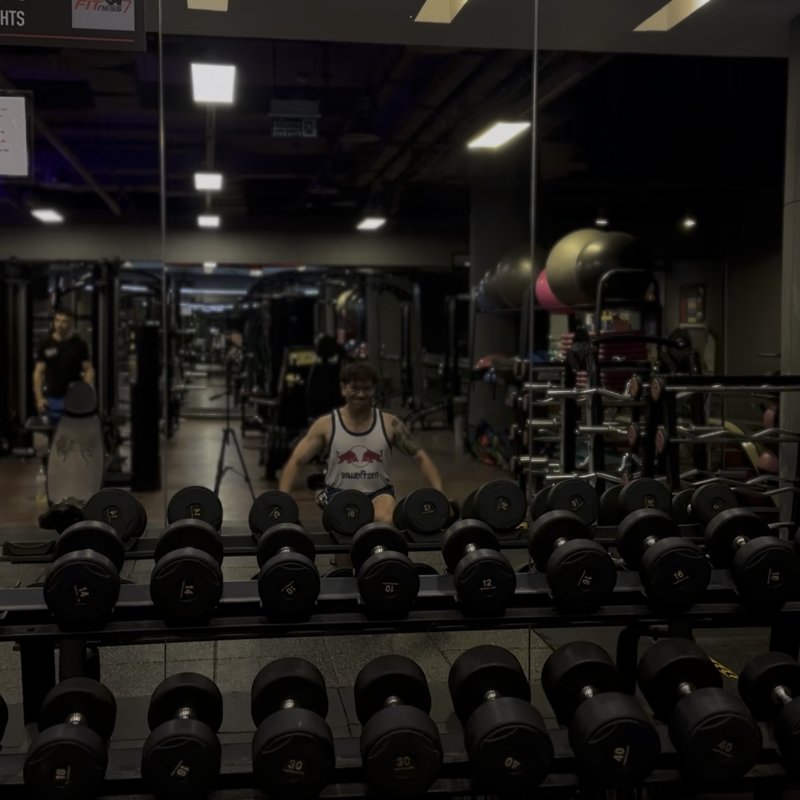Wznosy Hantli Bokiem: The Ultimate Guide
The Dumbbell Lateral Raise (Wznosy Hantli Bokiem) is an isolation exercise that specifically targets the lateral deltoids, raising the arms away from the sides of the body to build shoulder width and definition.

Quick Facts
Key Benefit
Lateral deltoid development and increased shoulder width
Primary Muscles
Medial Deltoids
Secondary Muscles
Abdominals, Anterior Deltoids, Forearms, Pectoralis Minor, Posterior Deltoids, Traps
Equipment
dumbbells
Difficulty
Beginner
Type
Isolation
In This Guide
Ready to master the Wznosy Hantli Bokiem?
Track your progress, see improvements over time, and build strength consistently.
Download GravitusThe Dumbbell Lateral Raise, also known as "Wznosy Hantli Bokiem" in Polish, is one of the most effective isolation exercises for developing the lateral (middle) head of the deltoid muscles. This movement specifically targets the muscle that gives the shoulders their width and contributes significantly to the coveted V-taper physique. Unlike compound pressing movements that emphasize the anterior (front) deltoid, lateral raises directly challenge the middle deltoid fibers through their primary function of abducting the arm away from the body. This isolation approach allows for precise targeting of a muscle group that might otherwise receive insufficient stimulation from compound exercises alone. The beauty of the lateral raise lies in its simplicity and effectiveness—by using relatively light weights with proper form, you can create substantial tension in the target muscle while minimizing stress on the joints. This makes it suitable for lifters of various experience levels and an excellent addition to virtually any upper body training program. Whether your goal is to build wider shoulders for aesthetic purposes, create balanced deltoid development, improve shoulder stability, or simply add an effective isolation movement to your routine, the dumbbell lateral raise delivers targeted stimulation with minimal equipment requirements.
Benefits of Dumbbell Lateral Raises
This fundamental isolation exercise offers several distinct advantages for shoulder development.
Lateral Deltoid Isolation
Directly targets the middle head of the deltoid, which is responsible for shoulder width and is often undertrained by compound pressing movements.
Balanced Development
Helps create proportional shoulder development by specifically addressing the lateral head to balance the anterior focus of most pressing exercises.
Joint-Friendly Option
When performed with proper form and appropriate weight, places less stress on the shoulder joint than heavy pressing movements.
Minimal Equipment
Requires only a pair of dumbbells, making it accessible for home workouts or busy commercial gyms.
Versatility
Can be performed with various modifications to accommodate different experience levels, mobility limitations, or training goals.
Visual Impact
Develops a muscle that significantly contributes to the appearance of athletic shoulders and upper body aesthetics.
Proper Form & Technique
Setup
- Select appropriate dumbbells that allow for proper form—typically lighter than you might use for other upper body exercises.
- Stand with feet shoulder-width apart to create a stable base.
- Hold a dumbbell in each hand at your sides with a neutral grip (palms facing your body).
- Maintain a slight bend in your elbows—approximately 10-15 degrees—that will remain constant throughout the movement.
- Stand tall with chest up, shoulders pulled back and down, and core engaged.
- Focus your gaze forward to help maintain proper posture.
- Ensure your wrists are in a neutral position, aligned with your forearms.
Movement
- Begin by taking a deep breath and bracing your core.
- Maintaining the slight bend in your elbows, raise your arms out to the sides.
- Lead with your elbows rather than your hands to optimize lateral deltoid engagement.
- Keep your shoulder blades down and back—avoid shrugging as you lift.
- Raise until your arms are approximately parallel to the floor (or slightly below for some individuals).
- At the top position, your palms should be facing downward or slightly angled with pinkies higher than thumbs.
- Briefly pause at the top position to maximize muscle activation.
- Slowly lower the weights back to the starting position with control, maintaining tension throughout.
- Avoid letting the dumbbells touch your sides between repetitions to keep constant tension on the deltoids.
- Exhale during the raising phase and inhale during the lowering phase.
- Repeat for the desired number of repetitions, focusing on quality over quantity.
Key Form Tips
Elbow Position
Maintain a consistent slight bend in your elbows throughout the movement—neither completely straight nor excessively bent.
Shoulder Position
Keep your shoulders down and back, avoiding the tendency to shrug as you raise the weights.
Movement Path
Lift directly out to the sides in the frontal plane, rather than allowing the weights to drift forward or backward.
Range of Motion
For most people, stopping with arms parallel to the floor is optimal—going higher can shift emphasis to the trapezius.
Wrist Alignment
Maintain neutral wrists aligned with your forearms throughout the movement to prevent strain.
Muscles Worked
Primary Muscles
- medial deltoids: The middle head of the deltoid muscle that forms the rounded contour of the shoulder is the primary target, responsible for abduction of the arm away from the body.
Secondary Muscles
- anterior deltoids: The front portion of the shoulder muscle assists in the movement, particularly if the arms drift slightly forward during the raise.
- posterior deltoids: The rear head of the deltoid provides stability and minor assistance, especially if a slight posterior lean to the arms is maintained.
- supraspinatus: One of the rotator cuff muscles that initiates abduction of the arm and works alongside the deltoids during the early phase of the lateral raise.
- traps: The upper portion of the trapezius muscle provides stability and may become engaged, particularly if the shoulders rise during the movement.
- pectoralis minor: The "boxer's muscle" assists in stabilizing the shoulder blade during the movement.
- forearms: The muscles of the forearm work isometrically to maintain grip on the dumbbells throughout the exercise.
- abdominals: The abdominals and lower back muscles work isometrically to maintain proper posture during the standing exercise.
Common Mistakes and How to Fix Them
Using Too Much Weight
Selecting a weight that's too heavy often leads to using momentum and improper form, reducing lateral deltoid activation. Choose a weight that allows you to perform the movement with strict form while feeling the targeted muscle working. If you find yourself swinging, leaning, or using momentum to move the weight, it's too heavy. Remember that lateral raises are an isolation exercise where form and mind-muscle connection are more important than the amount of weight used. Many experienced lifters use surprisingly light dumbbells (5-20 pounds) for effective lateral raise training. Focus on feeling the lateral deltoid doing the work rather than just moving weight from point A to point B.
Shrugging the Shoulders
Elevating the shoulders toward the ears during the movement shifts work from the deltoids to the trapezius. Keep your shoulders pulled down and back throughout the entire exercise. Before beginning each rep, consciously depress your shoulder blades, creating distance between your ears and shoulders. Maintain this position as you raise your arms. If you notice shoulder elevation occurring, it may indicate the weight is too heavy or that you're trying to raise your arms too high. Consider performing some sets in front of a mirror to monitor shoulder position until proper form becomes habitual.
Lifting Too High
Raising the arms significantly above shoulder level can lead to impingement issues and shifts emphasis away from the lateral deltoid. Stop the upward movement when your arms are approximately parallel to the floor (or slightly below for some individuals). If you're consistently raising higher, it may be due to momentum, excessive trapezius involvement, or simply a misunderstanding of proper form. Use a mirror to check your endpoint, or have a training partner provide feedback. For most people, raising to shoulder height provides optimal lateral deltoid activation while minimizing stress on the shoulder joint.
Using Momentum
Swinging the body or using momentum to move the weight reduces the effectiveness of the exercise and increases injury risk. Control the movement throughout the entire range of motion, especially during the lowering phase. Implement a deliberate tempo—for example, 2 seconds up, 1-second pause at the top, 3 seconds down—to eliminate momentum. Focus on feeling the lateral deltoid doing the work rather than just moving the dumbbell from point A to point B. If maintaining strict form is challenging, reduce the weight until proper execution is possible.
Incorrect Arm Position
Allowing the arms to drift too far forward or backward during the movement alters muscle recruitment patterns. Raise your arms directly out to the sides in the frontal plane for optimal lateral deltoid engagement. If your arms drift forward, you'll shift emphasis to the anterior deltoid; if they drift backward, you'll engage more posterior deltoid. While slight variations in arm angle can be used intentionally to emphasize different portions of the deltoid, for standard lateral raises, aim for movement in the frontal plane. Some lifters find it helpful to perform the exercise with their back against a wall to reinforce proper movement mechanics.
Bent Wrists
Allowing the wrists to flex or extend during the movement can lead to strain and reduces force transfer. Maintain neutral wrists aligned with your forearms throughout the exercise. Think of your hands as extensions of your forearms, creating a straight line from elbow to knuckles. If wrist position is consistently problematic, it may indicate the weight is too heavy or that grip fatigue is occurring before deltoid fatigue. Consider using lighter weights with stricter form or implementing specific wrist strengthening exercises as part of your program.
Exercise Variations
Position Variations
-
Seated Lateral Raise
Performing the movement while seated on a bench to eliminate potential body english and isolate the lateral deltoids more completely.
-
Leaning Lateral Raise
Leaning slightly away from the working arm (for single-arm variation) or against a support to create a different angle of resistance and increase tension at the bottom portion of the movement.
-
Incline Bench Lateral Raise
Lying sideways on an incline bench while performing the raise, which helps eliminate momentum and cheating while providing a different resistance curve.
-
Cable Lateral Raise
Using a cable machine instead of dumbbells to provide constant tension throughout the entire range of motion, particularly at the bottom position.
Execution Variations
-

Partial Range Lateral Raise
Performing the movement through a limited range (typically the top half) to maintain constant tension in the area of maximum lateral deltoid contraction.
-

21s Lateral Raise
Performing 7 partial reps in the bottom half of the range, 7 partial reps in the top half, and 7 full range repetitions to thoroughly fatigue the muscle.
-
Alternating Lateral Raise
Raising one arm at a time in alternating fashion, which can improve mind-muscle connection and reduce overall fatigue during high-rep sets.
-

Pause Lateral Raise
Adding a deliberate 2-3 second isometric hold at the top position to increase time under tension and enhance mind-muscle connection.
Advanced Variations
-

Drop Set Lateral Raise
Performing a set to near failure, then immediately reducing the weight and continuing for additional repetitions without rest.
-
Banded Lateral Raise
Adding resistance bands for accommodating resistance that increases as you approach the top position.
-

Mechanical Drop Set
Starting with a more difficult variation (like strict form with palms down) and transitioning to an easier variation (like thumbs up with slight forward lean) as fatigue sets in.
-
Rear Lateral Raise
Performing the movement with the arms behind the torso, which shifts emphasis to the posterior portion of the lateral deltoid.
Frequently Asked Questions
The appropriate weight for lateral raises is typically much lighter than many people initially expect, as this is a strict isolation exercise targeting a relatively small muscle group. Most experienced lifters use surprisingly moderate weights—men often use 10-25 pounds per dumbbell and women 5-15 pounds, even after years of training. Rather than focusing on a specific number, select a weight that allows you to maintain proper form throughout the entire set while feeling targeted work in the lateral deltoid. Signs that you've selected an appropriate weight include: (1) ability to raise the arms without shrugging the shoulders, (2) controlled movement without momentum or body english, (3) feeling the work primarily in the lateral deltoid rather than the traps or other muscles, and (4) maintaining the same slight elbow bend throughout the movement. If you find yourself using body swing, shrugging your shoulders, or bending the elbows significantly during the movement, the weight is too heavy. Remember that the lateral raise is a precision movement designed to isolate a specific muscle—focus on quality of contraction rather than the quantity of weight used. Many advanced bodybuilders maintain relatively light weights for lateral raises throughout their careers, prioritizing strict form and mind-muscle connection over heavier loads.
The optimal hand position during lateral raises depends somewhat on individual comfort and specific training goals, but certain positions tend to create better lateral deltoid activation. For standard lateral raises, a neutral grip at the starting position (palms facing your body) that gradually rotates to a slightly pronated position (thumbs slightly lower than pinkies) at the top typically provides optimal lateral deltoid engagement. This "thumb-down" or "empty can" position at the top—where your pinky is slightly higher than your thumb—has been shown in EMG studies to create strong lateral deltoid activation. However, this position can be uncomfortable for some individuals with certain shoulder conditions. A neutral "thumbs up" position throughout the movement is generally more shoulder-friendly and still provides good deltoid recruitment, making it suitable for those with shoulder issues or discomfort. The traditional fully pronated position (palms directly facing the floor) works well for many lifters but may create less optimal leverage for the lateral deltoid. As with many exercise technique points, some experimentation is beneficial to discover which hand position creates the strongest mind-muscle connection and comfort for your individual structure. Many advanced lifters actually vary their hand position between different sets or workouts to provide slightly different stimulation to the muscle.
For optimal lateral deltoid activation with minimal risk of shoulder impingement, raise your arms until they reach approximately shoulder height—parallel to the floor or very slightly below. This range typically provides maximum lateral deltoid engagement while minimizing excessive trapezius involvement and reducing potential shoulder joint stress. The exact height may vary slightly between individuals based on shoulder anatomy and mobility. Several indicators can help determine your ideal end position: First, you should feel maximum tension in the lateral deltoid at the top of the movement. Second, you should be able to maintain proper form without shrugging your shoulders toward your ears. Third, the movement should feel comfortable without any pinching or pain in the shoulder joint. If you experience discomfort when raising to shoulder height, try a slightly lower end position or experiment with different hand positions (particularly a thumbs up orientation) which may be more comfortable. Avoid the common mistake of trying to raise the arms as high as possible, as extreme elevation shifts emphasis to the trapezius and can potentially create shoulder impingement issues. For most people, stopping right at or slightly below shoulder level provides the optimal balance of effectiveness and joint health.
Your arms should maintain a slight, consistent bend throughout the entire lateral raise movement—neither completely straight nor significantly bent. This subtle bend (approximately 10-15 degrees) serves several important purposes: First, it reduces stress on the elbow joint itself. Second, it places the lateral deltoid in a slightly better mechanical position for optimal activation. Third, it helps reduce strain on the shoulder joint compared to completely straight arms. The key principle is maintaining the same degree of elbow bend from start to finish—your elbow angle should remain unchanged throughout the movement. If you keep your arms completely straight, you may place excessive stress on the elbow joints and potentially reduce lateral deltoid activation. Conversely, if you bend your elbows significantly or change the angle during the movement, you transform the exercise into more of a hybrid movement or upright row, reducing its effectiveness as a lateral deltoid isolation exercise. Some experimentation with the exact degree of elbow bend may be beneficial to find what creates the strongest lateral deltoid contraction for your individual biomechanics, but the principle of maintaining consistent elbow positioning throughout the movement remains constant regardless of the specific angle chosen.
Most people achieve optimal results training each major muscle group 2-3 times per week, with direct lateral deltoid work like lateral raises included in some or all of these sessions. For the average trainee focused on balanced development, performing lateral raises 2 times weekly provides sufficient stimulus while allowing adequate recovery. If shoulders are a particular focus or lagging body part, you might include lateral raise variations in up to 3 weekly sessions, potentially varying the specific exercise (dumbbell, cable, machine) and intensity techniques between workouts. It's important to consider that the deltoids also receive significant indirect work during many pressing movements (bench press, overhead press, push-ups), so total shoulder training volume must be considered, not just direct isolation work. Within each shoulder training session, a typical approach includes 3-4 sets of lateral raises, with total volume potentially higher during specialization phases. Pay attention to recovery indicators—if shoulder performance decreases between sessions or joint discomfort develops, you may need to reduce frequency or volume. Remember that progression (through increased weight, reps, or intensity techniques) is more important than extreme frequency for continued development. For most trainees, incorporating lateral raises twice weekly with varied execution and progressive overload creates the optimal balance of stimulus and recovery.
Track your progress with Gravitus
Download Gravitus to log your workouts, track your progress, and join a community of fitness enthusiasts.

Helpful Resources
One Rep Max Calculator
Find your one rep max for any exercise without maximal testing. Essential for developing effective strength training programs.
Calculate 1RMWorkout Programs
Follow structured workout programs created by fitness professionals to maximize your strength and muscle gains.
View Programs






